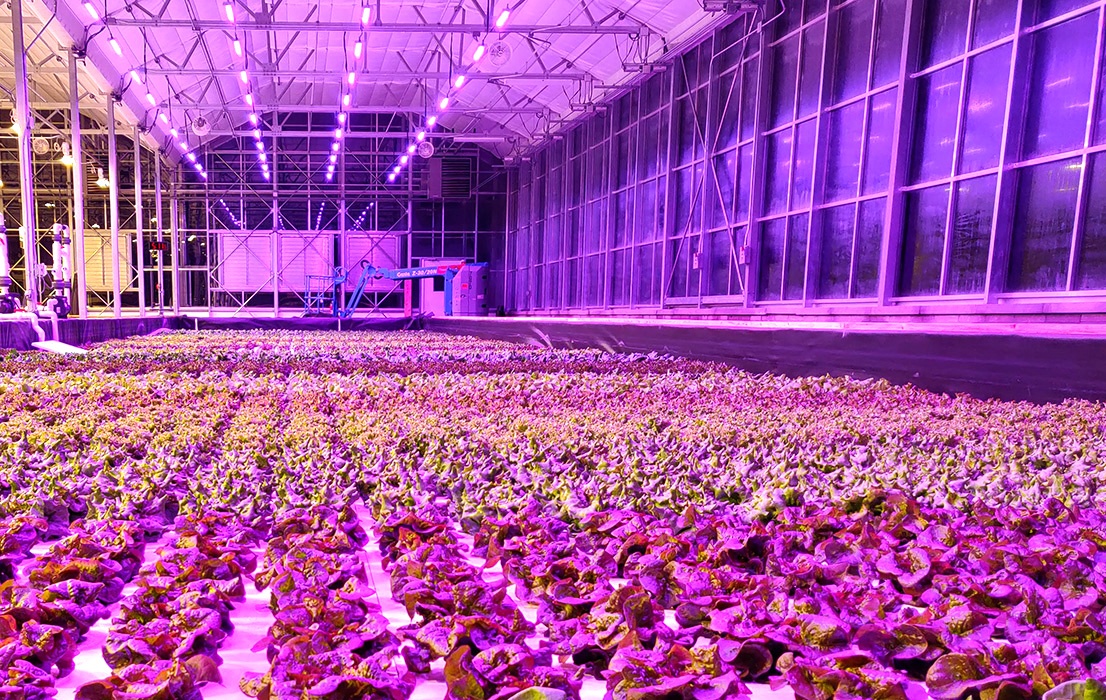
All crops have specific light requirements. By knowing minimum and optimum levels of light for our crop we can manage our environment to improve crop performance. When the ambient light exposure is below the minimum requirements we need to apply supplemental lighting in order to maintain our crop production at a healthy and consistent pace.
On the other hand when our ambient light levels are optimal we can regulate light to influence other aspects of our environment such as air temperature and humidity by applying specific products to reduce heat exposure in our greenhouse.
Light management will always be a key factor in our crop performance. As our series continues we will discuss specific products to manage light and heat within your greenhouse. Let’s take a look at some crop specific light requirements and how they affect our crop performance.
DLI or Daily Light Integral refers to the number photons received by a plant that provide photosynthetic activation.
Lettuce and Herbs – Minimum 12 DLI, Optimum 17 DLI
Lettuce and herbs are crops that can be grown in both greenhouse and indoor vertical farming. Maintaining DLI below 17 for an indoor vertical farming system is recommended in order to mitigate environmental conditions which can affect calcium uptake and cause tip burn in your crop.
Lettuce and some herbs are extremely sensitive to high temperatures. Therefore, proper DLI management inside a greenhouse reduces the chances of accumulating excess heat that could promote bolting of your crop and the proliferation of both mildew and pest. Thus, because of its influence on temperature, light management is very important to maintain optimum environmental conditions to achieve the product quality required for the market.
Tomatoes (Minimum 20 DLI), Cucumbers (Minimum 15 DLI) and Peppers (Minimum 20 DLI) – Optimum 30 DLI
Tomatoes, cucumbers and peppers are crops with higher DLI requirements than their leafy green cousins. They also enjoy a higher temperature. One major challenge when growing tomatoes, peppers, cucumbers vertically inside a greenhouse is how to achieve a uniform distribution of DLI for stable consistent fruit generation. Tall crops tend to shade each other, creating an environment where optimal DLI levels are only achieved in the upper canopy. To counteract this effect when relying heavily on ambient light diffusion creating products, such as shade paints, must be employed to scatter the light in different directions to reach every level of the canopy.
Properly designed supplemental lighting can also be employed to reach all levels of the plant canopy and maintain balanced DLI levels when ambient light is insufficient. Too much direct light can cause stress in young leaves and also can cause sunburn issues in fruit. Remember to always use the right products to maintain proper DLI levels and control how light is entering your greenhouse.
Hemp – Minimum 20 DLI, Optimum 30 DLI
Hemp is a crop that loves light, and can be grown under conditions similar to tomatoes, cucumbers and peppers. However, when cultivating hemp, maintaining the proper photoperiod is just as important to production as optimizing DLI. Previous research demonstrated short days promote flowering in this crop, and has also concluded that environmental factors such as temperature and photoperiod, can greatly influence the reproductive cycles of Hemp.
There are three distinct phases in Hemp cultivation: propagation, vegetative and flowering. Recent research regarding light application for high yield production purposes recommend the use of long photoperiods (18 hours) for the propagation and vegetative phases and short photoperiods (12 hours) for the flowering phase when using artificial lighting.
Strawberry – Minimum 17 DLI, Optimum 20 DLI
Strawberries enjoy a much lower light requirement than vine crops. Due to plant anatomy diffuse lighting is also recommended to enhance photosynthetic activity in strawberries and avoid leaf shading within the plant. Strawberry cultivars have a strong response to both photoperiod and temperature. We can find short-day, long-day and day-neutral cultivars in strawberries.
Previous research demonstrated that the most common type of cultivar on the market, day-neutral, can also exhibit an accelerated flowering response under long-day conditions. Therefore, by the use of supplemental lighting, it is possible to promote more abundant flowering earlier in strawberries and have your crop ready for the market in less time. Lower temperatures during non-photosynthetic activation periods have been shown to improve flavor.
Microgreens – Minimum 10 DLI, Optimum 12 DLI
Microgreens are young plants with low light requirements grown in vertical farming systems using artificial lighting and harvested before ever reaching maturity. Because these crops have such a fast rate of growth it is important to monitor and maintain proper DLI levels to avoid over-stretching due to low light or burning due to excess light. Usually light-burn can be triggered when plants are too close to lamps.
An important aspect to get perfect size, texture and color microgreens is to work with good light quality. Most often the correct balance of red and blue lighting can achieve great quality in microgreens.
We’re here to help
At Hort Americas, we have multiple solutions to manage lighting inside your growing environment. From light monitoring systems (30 MHz), to ambient light control products for your greenhouse (SUDLAC). We also work hand in hand with the LED light experts at (Current By GE) to provide artificial lighting solutions to help you reach the optimum DLI for your crops with industry leading efficacy and efficiency. Contact us today to learn how to master your crop performance!
-
Product on sale
 Arize® Element L1000 Greenhouse LED Grow Light Gen 1Original price was: $995.00.$750.00Current price is: $750.00.
Arize® Element L1000 Greenhouse LED Grow Light Gen 1Original price was: $995.00.$750.00Current price is: $750.00. -
 SUDLAC Transpar$185.00
SUDLAC Transpar$185.00


